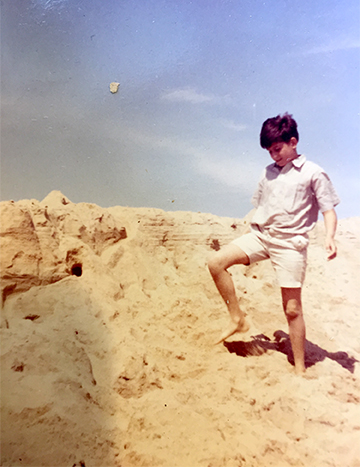Henry’s Sanctuary
By Peter Brooks

Young Peter Brooks, Photo courtesy of Peter Brooks
Henry Beetle Hough’s 1958 gift of land to the nascent Sheriff’s Meadow Foundation created a refuge, the Sheriff’s Meadow Sanctuary, that stands today as a testament to his remarkable vision, and generosity.
It also created a perfect playground for this not-quite-ten-year-old summer transplant from New York, though it was clear early on that Henry didn’t quite buy in to this alternate vision.
You can guess who won out. But let me explain.
Summers in the late 1950’s and early 1960’s were spent in a daily romp of boundless energy, and the Sanctuary was soon discovered to be the almost idyllic environment. In those days we would arrive from New York in mid-June and immediately park our shoes in our closets until early September, when we returned to the City. From our summer rental, just yards away from the Planting Field Way entrance, the Sanctuary was our ready playground. My sister, Candy, remembers the feel of the sandy path covered with pine needles on her bare feet. My friend, Johnny, and I would tear along the paths on our red Huffy bikes, racing around the Sanctuary to see who had emerged from the winter the fastest. We would play cops and robbers, cowboys and Indians, and we would pretend we were explorers discovering a wilderness filled with ferocious animals, alligators everywhere and an occasional dragon. Often, our black, standard poodle, Baba, would be running untethered somewhere near us, thrilling at the same unbridled freedom from the constraints of New York as we.
Then, around the corner, we would spot a man and a dog, and we would be reminded: this was Henry’s Sanctuary. Each day, twice a day as I recall, Henry and Lochinvar, his much loved collie, would leave their Sheriff’s Lane home and take a walk around the Sanctuary. Henry would stride with his long legs, often with a bit of a stoop at his shoulders that is not uncommon with men who are tall, and maybe a bit shy, and Lochinvar would prance leashed to his side, the well-groomed Collie fur waving slightly in the breeze from the dog’s eager stride.
To say Henry was not pleased to see us would grossly understate the situation. You see, just as today, bikes weren’t allowed in the Sanctuary, dogs were to be leashed, and noise was to be minimized. Simply put: Henry did not view our revelry with quite the same unbridled joy as we did.
His manner of reprimand spoke volumes about the man. Henry was a gentle person who, I suspect, found it hard to be too stern or too angry (I suppose Flo, Walter and other members of the staff of the Gazette might contest this assertion, but I think not). In a soft, but firm, voice Henry would remind us that essentially nothing we were doing was allowed in the Sanctuary and ask us to “play” elsewhere. We would always agree without complaint, almost elated to only receive another verbal reminder instead of what we supposed could have been much worse. We would head to the Planting Field Way entrance dutifully.
These encounters with Henry went on for a number of years until, eventually, we outgrew the carefree passions of childhood and began to enter, haltingly, the maturity of adulthood. Over the years, our forays into the Sanctuary took on a different hue. We walked the paths to savor the beauty of the place and to offer a setting for soul searching talks with friends as we faced the challenges of adult life. We reminisced about the frolics of our youth, and the frequent encounters with Henry, but the serenity of the place is what we sought and what we found.
Fortunately for us, Henry didn’t seem to harbor any deep-seated resentment at the indiscretions of our youth, becoming eventually a treasured mentor who was instrumental in helping to secure our first job out of college: working the linotype, laying lead type in the galleys and writing an occasional article for the Gazette which, by then, he had sold to Scotty and Sally Reston.
I now walk the paths around the Sanctuary almost every day I’m on the Island. I marvel at its timelessness, its beauty, its tranquility. And I think of Henry. I imagine him around the next corner with Lochinvar striding purposefully, Henry’s head just slightly bent as was so often the case. I envision stopping and discussing with Henry the beauty of the day, commenting on the two swans who for years have called the pond their home and wondering how many years it will take for the water from the globally warmed Sound to overtake the salt marsh in the northeast corner.
The Sanctuary is a special place, perhaps even more so today than 60 years ago when Henry originally gifted his land to the Foundation. Some things have changed—the meadows are smaller and the pond views not quite as open—but it remains a natural refuge in the midst of a town that has become increasingly bustling around it.
And it remains, as it should, Henry’s Sanctuary.
Peter Brooks and his family began coming to Edgartown in the Summer of 1954, and today Peter, Nancy and their family have a small house in Edgartown on Pierce Lane, backing up to the Sanctuary. Peter joined the Sheriff’s Meadow board of directors in 2017.
Photo of young Peter Brooks courtesy of Peter Brooks.

